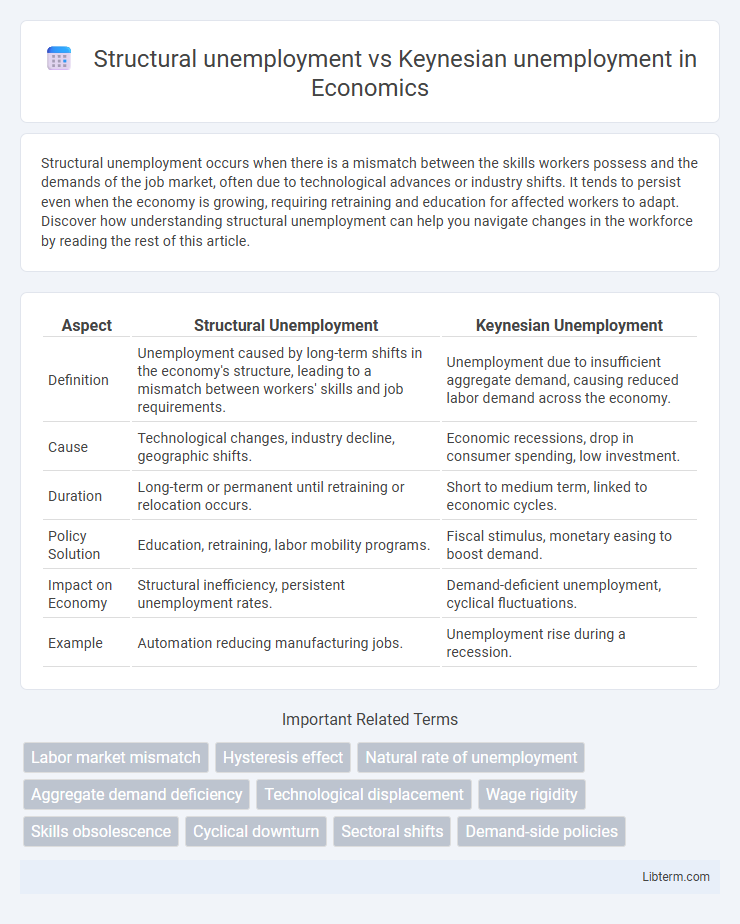Structural unemployment occurs when there is a mismatch between the skills workers possess and the demands of the job market, often due to technological advances or industry shifts. It tends to persist even when the economy is growing, requiring retraining and education for affected workers to adapt. Discover how understanding structural unemployment can help you navigate changes in the workforce by reading the rest of this article.
Table of Comparison
| Aspect | Structural Unemployment | Keynesian Unemployment |
|---|---|---|
| Definition | Unemployment caused by long-term shifts in the economy's structure, leading to a mismatch between workers' skills and job requirements. | Unemployment due to insufficient aggregate demand, causing reduced labor demand across the economy. |
| Cause | Technological changes, industry decline, geographic shifts. | Economic recessions, drop in consumer spending, low investment. |
| Duration | Long-term or permanent until retraining or relocation occurs. | Short to medium term, linked to economic cycles. |
| Policy Solution | Education, retraining, labor mobility programs. | Fiscal stimulus, monetary easing to boost demand. |
| Impact on Economy | Structural inefficiency, persistent unemployment rates. | Demand-deficient unemployment, cyclical fluctuations. |
| Example | Automation reducing manufacturing jobs. | Unemployment rise during a recession. |
Introduction to Unemployment Types
Structural unemployment occurs when there is a mismatch between workers' skills and job requirements, often due to technological advances or shifts in industry demand, leading to long-term joblessness. Keynesian unemployment arises from insufficient aggregate demand in the economy, causing temporary layoffs and underutilization of labor during economic downturns. Understanding these unemployment types is crucial for designing targeted economic policies that address the root causes of joblessness.
Defining Structural Unemployment
Structural unemployment occurs when there is a mismatch between workers' skills and the demands of the labor market, often due to technological advancements or shifts in industry sectors. This type of unemployment persists even during periods of economic growth, as displaced workers struggle to find jobs without retraining or relocation. Keynesian unemployment, by contrast, arises from insufficient aggregate demand, causing temporary job shortages across various sectors.
Exploring Keynesian Unemployment
Keynesian unemployment arises from insufficient aggregate demand in the economy, leading to idle labor despite available jobs. It contrasts with structural unemployment, which results from mismatches between workers' skills and job requirements due to technological changes or shifts in industries. Keynesian theory advocates government intervention through fiscal stimulus to boost demand and reduce unemployment levels.
Core Differences: Structural vs Keynesian Unemployment
Structural unemployment arises from fundamental shifts in the economy, such as technological advancements or changes in consumer preferences, leading to a mismatch between workers' skills and job requirements. Keynesian unemployment occurs due to insufficient aggregate demand, causing a general shortage of jobs despite the availability of a capable workforce. The core difference lies in structural unemployment being a long-term issue requiring retraining and economic adaptation, whereas Keynesian unemployment is typically short-term and addressed through demand-side fiscal and monetary policies.
Causes of Structural Unemployment
Structural unemployment arises from fundamental shifts in an economy, such as technological advancements, changes in consumer demand, or globalization that render certain skills obsolete. Unlike Keynesian unemployment, caused primarily by insufficient aggregate demand, structural unemployment results from mismatches between workers' skills and job requirements or geographic dislocations. Industries undergoing automation or outsourcing often experience increased structural unemployment as labor markets adjust to new economic realities.
Causes of Keynesian Unemployment
Keynesian unemployment arises primarily from insufficient aggregate demand, leading to a shortfall in job creation despite the availability of labor. It typically occurs during economic downturns when consumer spending and investment decline, causing businesses to reduce output and lay off workers. Unlike structural unemployment, which stems from mismatches between skills and job requirements, Keynesian unemployment is driven by cyclical factors affecting overall economic activity.
Impact on the Labor Market
Structural unemployment results from mismatches between workers' skills and available jobs, causing long-term joblessness and reducing labor market efficiency by increasing the skills gap. Keynesian unemployment occurs due to insufficient aggregate demand, leading to cyclical job losses and underutilized labor resources during economic downturns. Both types affect wage dynamics and employment rates but differ in policy responses, with structural unemployment requiring retraining programs and Keynesian unemployment needing demand-stimulating measures.
Policy Solutions for Structural Unemployment
Policy solutions for structural unemployment focus on enhancing workforce skills through targeted retraining programs and vocational education to match evolving industry demands. Investments in labor market flexibility, such as improved job matching platforms and incentives for geographic mobility, help reduce mismatches between workers and job openings. Government initiatives promoting innovation and support for emerging sectors further facilitate structural adjustments within the economy.
Policy Responses to Keynesian Unemployment
Keynesian unemployment arises from insufficient aggregate demand, leading to underutilized labor and output gaps in the economy. Policy responses to Keynesian unemployment emphasize expansionary fiscal measures such as increased government spending and tax cuts to stimulate demand and boost employment. Monetary policy tools, including lowering interest rates, are also employed to encourage investment and consumption, thereby reducing unemployment driven by demand deficiencies.
Long-Term Economic Implications
Structural unemployment arises from fundamental shifts in the economy, such as technological advancements or changing industry demands, leading to persistent mismatches between workers' skills and job requirements, which can slow long-term economic growth and reduce labor market efficiency. Keynesian unemployment, caused by insufficient aggregate demand, tends to be cyclical and may be mitigated through fiscal and monetary policies, supporting a quicker recovery in employment levels and overall economic activity. Long-term implications of structural unemployment include the need for retraining programs and labor market reforms, while Keynesian unemployment highlights the importance of active economic stabilization policies to maintain demand and reduce output gaps.
Structural unemployment Infographic

 libterm.com
libterm.com